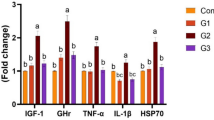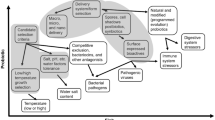Abstract
It is a practical approach to select candidate probiotic bacterial stains on the basis of their special traits. Production of digestive enzyme was used as a trait to select a candidate probiotic bacterial strain in this study. In order to select a bacterium with the ability to degrade both starch and protein, an ideal bacterial strain STE was isolated from marine shrimp (Litopenaeus vannamei) intestines by using multiple selective media. The selected isolate STE was identified on the basis of its morphological, physiological, and biochemical characteristics as well as molecular analyses. Results of degradation experiments confirmed the ability of the selected isolate to degrade both starch and casein. The isolate STE was aerobic, Gram-negative, rod-shaped, motile and non-spore-forming, and had catalase and oxidase activities but no glucose fermentation activity. Among the tested carbon/nitrogen sources, only Tween40, alanyl-glycine, aspartyl-glycine, and glycyl-l-glutamic acid were utilized by the isolate STE. Results of homology comparison analyses of the 16S rDNA sequences showed that the isolate STE had a high similarity to several Pseudoalteromonas species and, in the phylogenetic tree, grouped with P. ruthenica with maximum bootstrap support (100%). In conclusion, the isolate STE was characterized as a novel strain belonging to the genus Pseudoalteromonas. This study provides a further example of a probiotic bacterial strain with specific characteristics isolated from the host gastrointestinal tract.
Similar content being viewed by others
References
Ai, Q., Mai, K., Zhang, W., Xu, W., Tan, B., Zhang, C., and Li., H., 2007. Effects of exogenous enzymes (phytase, non-starch polysaccharide enzyme) in diets on growth, feed utilization, nitrogen and phosphorus excretion of Japanese seabass, Lateolabrax japonicus. Comparative Biochemistry and Physiology, Part A, 147(2): 502–508.
Balcázar, J. L., Vendrell, D., de Blas, I., Ruiz-Zarzuela, I., Muzquiz, J. L., and Girones, O., 2008. Characterization of probiotic properties of lactic acid bacteria isolated from intestinal microbiota of fish. Aquaculture, 278: 188–191.
Del Piano, M., Morellic, L., Strozzib, G. P., Allesina, S., Barbab, M., Deidda, F., Lorenzini, P., Ballaré, M., Montino, F., Orsello, M., Sartori, M., Garello, E., Carmagnola, S., Pagliarulo, M., and Capurso, L., 2006. Probiotics: from research to consumer. Digestive and Liver Disease, 38(Supplement 2): S248–S255.
Felsenstein, J., 2004. Inferring Phylogenies. Sinauer Associates, Sunderland, Massachusetts, USA, 664 pp
Gallagher, J. M., Carton, M. W., Eardly, D. F., and Patching, J. W., 2004. Spatio-temporal variability and diversity of water column prokaryotic communities in the eastern North Atlantic. FEMS Microbiology Ecology, 47: 249–262.
Garrity, G. M., Brenner, D. J., Krieg, N. R., and Staley, J. T., 2005. Bergey’s Manual of Systematic Bacteriology: The Proteobacteria, Part B, The Gammaproteobacteria, 2nd edition, volume 2. Springer-Verlag, New York, USA, 1103 pp.
Gomez-Gil, B., Roque, A., and Turnbull, J. F., 2000. The use and selection of probiotic bacteria for use in the culture of larval aquatic organisms. Aquaculture, 191: 259–270.
Higgins, D. G., Thompson, J. D., and Gibson, T. J., 1996. Using CLUSTAL for multiple sequence alignments. Methods in Enzymology, 266: 383–402.
Holzapfel, W. H., Haberer, P., Snel, J., Schillinger, U., and Huis in’t Veld, J. H. J., 1998. Overview of gut flora and probiotics. International Journal of Food Microbiology, 41: 85–101.
Jacob, M. B., and Gerstein, M. J., 1960. Handbook of Microbiology. D. Van Nostrand Company, Inc, Princeton, NJ, USA, 61 pp.
Kar, N., and Ghosh, K., 2008. Enzyme producing bacteria in the gastrointestinal tracts of Labeo rohita (Hamilton) and Channa punctatus (Bloch). Turkish Journal of Fisheries and Aquatic Sciences, 8: 115–120.
Kudsk, K. A., 2002. Current aspects of mucosal immunology and its influence by nutrition. The American Journal of Surgery, 183: 390–398.
Kumar, S., Dudley, J., Nei, M., and Tamura, K., 2008. MEGA: A biologist-centric software for evolutionary analysis of DNA and protein sequences. Briefings in Bioinformatics, 9(4): 299–306.
Ma, Y., Zeng, Y., Jiao, N., Shi Y., and Hong, N., 2009. Vertical distribution and phylogenetic composition of bacteria in the Eastern Tropical North Pacific Ocean. Research in Microbiology, 164: 624–633.
Mishra, S., and Behera, N., 2008. Amylase activity of a starch degrading bacteria isolated from soil receiving kitchen wastes. African Journal of Biotechnology, 7: 3326–3331.
Montagne, L., Pluske, J. R., and Hampson, D. J., 2003. A review of interactions between dietary fibre and the intestinal mucosa, and their consequences on digestive health in young non-ruminant animals. Animal Feed Science and Technology, 108: 95–117.
Montalto, M., D’Onofrio, F., Gallo, A., Cazzato, A., and Gasbarrini, G., 2009. Intestinal microbiota and its functions. Digestive and Liver Disease, 3: 30–34.
Omondi, J. G., and Stark, J. R., 1996. In vitro carbohydrate digestibility tests in the Indian white shrimp, Penaeus indicus. Aquaculture, 139(3–4): 315–328.
Ouwehand, A. C., Kirjavainen, P. V., Shortt, C., and Salminen, S., 1999. Probiotics: mechanisms and established effects. International Dairy Journal, 9: 43–52.
Panigrahi, A., Kiron, V., Kobayashi, T., Puangkaew, J., Satoh, S., and Sugita, H., 2004. Immune responses in rainbow trout Oncorhynchus mykiss induced by a potential probiotic bacteria Lactobacillus rhamnosus JCM 1136. Veterinary Immunology and Immunopathology, 10: 379–388.
Patel, A. K., Ahire, J. J., Pawar, S. P., Chaudhari, B. L., and Chincholkar, S. B., 2009. Comparative accounts of probiotic characteristics of Bacillus spp. isolated from food wastes. Food Research International, 42: 505–510.
Ramachandran, S., Bairagi, A., and Ray, A. K., 2005. Improvement of nutritive value of grass pea (Lathyrus sativus) seed meal in the formulated diets for rohu, Labeo rohita (Hamilton) fingerlings after fermentation with a fish gut bacterium. Bioresource Technology, 96: 1465–1472.
Sizemore, R. K., and Stevenson, L. H., 1970. Method for the isolation of proteolytic marine bacteria. Applied and Environmental Microbiology, 20: 991–992.
Sneath, P. H. A., Mair, N. S., Sharp, M. E., and Holt J. G., 1986. Bergey’s manual of systematic bacteriology, Williams and Willkins, Baltimore, USA, 467–477.
Son, V. M., Chang, C. C., Wu, M. C., Gu, Y. K., Chiu, C. H., and Cheng, W., 2009. Dietary administration of the probiotic, Lactobacillus plantarum, enhanced the growth, innate immune responses, and disease resistance of the grouper Epinephelus coioides. Fish and Shellfish Immunology, 26: 691–698.
Suzer, C., Çoban, D., Kamaci, H. O., Saka, Ş., Firat, K., Otgucuoǧlu, Ö., and Küçüksari, H., 2008. Lactobacillus spp. bacteria as probiotics in gilthead sea bream (Sparus aurata, L.) larvae: Effects on growth performance and digestive enzyme activities. Aquaculture, 280: 140–145.
Takaoki, T., 1917. The influence of conditions of bacterial cleavage of proteins on the cleavage products. Journal of Biological Chemistry, 32: 527–532.
Toit, M. du, Franz, C. M. A. P., Dicks, L. M. T., Schillinger, U., Haberer, P., Warlies, B., Ahrens, F., and Holzapfel, W. H., 1998. Characterization and selection of probiotic lactobacilli for a preliminary mini-pig feeding trial and their effect on serum cholesterol levels, faeces pH and faeces moisture content. International Journal of Food Microbiology, 40: 93–104.
Tovar, D., Zambonino, J., Cahu, C., Gatesoupe, F. J., Vázquez-Juárez, R., and Lésel, R., 2002. Effect of live yeast incorporation in compound diet on digestive enzyme activity in sea bass (Dicentrarchus labrax) larvae. Aquaculture, 204: 113–123.
Weisburg, W. G., Barns, S. M., Pelletier, D. A., and Lane, D. J., 1991. 16S ribosomal DNA amplification for phylogenetic study. Journal of Bacteriology, 173: 697–703.
Author information
Authors and Affiliations
Corresponding author
Rights and permissions
About this article
Cite this article
Li, J., Tan, B. & Mai, K. Isolation and identification of a bacterium from marine shrimp digestive tract: A new degrader of starch and protein. J. Ocean Univ. China 10, 287–292 (2011). https://doi.org/10.1007/s11802-011-1849-7
Received:
Revised:
Accepted:
Published:
Issue Date:
DOI: https://doi.org/10.1007/s11802-011-1849-7




